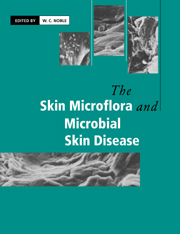Book contents
- Frontmatter
- Contents
- List of contributors
- Preface
- 1 The basis of the skin surface ecosystem
- 2 Nutrition of cutaneous resident microorganisms
- 3 Physical factors affecting the skin flora and skin disease
- 4 Coryneform bacteria
- 5 Coryneforms as pathogens
- 6 Staphylococci on the skin
- 7 Staphylococci as pathogens
- 8 Streptococci and the skin
- 9 Other cutaneous bacteria
- 10 Fungi and fungal infections of the skin
- 11 Bacterial and fungal skin disease in animals
- 12 Viral skin disease in man
- 13 Viral skin disease in animals
- 14 Microbial interactions on skin
- 15 Adherence of skin microorganisms and the development of skin flora from birth
- 16 Skin disinfection
- Index
1 - The basis of the skin surface ecosystem
Published online by Cambridge University Press: 04 December 2009
- Frontmatter
- Contents
- List of contributors
- Preface
- 1 The basis of the skin surface ecosystem
- 2 Nutrition of cutaneous resident microorganisms
- 3 Physical factors affecting the skin flora and skin disease
- 4 Coryneform bacteria
- 5 Coryneforms as pathogens
- 6 Staphylococci on the skin
- 7 Staphylococci as pathogens
- 8 Streptococci and the skin
- 9 Other cutaneous bacteria
- 10 Fungi and fungal infections of the skin
- 11 Bacterial and fungal skin disease in animals
- 12 Viral skin disease in man
- 13 Viral skin disease in animals
- 14 Microbial interactions on skin
- 15 Adherence of skin microorganisms and the development of skin flora from birth
- 16 Skin disinfection
- Index
Summary
The compelling challenge of exploration has, with the advent of space probes, been extended to include much closer investigation of a variety of distant planets and their potential to support life. As spaceships reveal more and more surface environments that are barren and hostile to human habitation, like that of the moon, the enormity of the search for planets suitable for colonization is emphasized.
There are, however, equally demanding and exciting investigative challenges, though requiring different technical skills, if the telescope is exchanged for the microscope. We need look no further than ourselves to find micro-worlds ripe for exploration; each of us provides a surface that supports an interactive microbial population, the location and composition of which is dependent upon the structure and metabolism of the layers that compose our skin.
Microorganisms float unseen in the air around us, often on ‘flying saucers’ of keratin a few microns in diameter, which, as we shall see later, are derived from the surfaces of different mammals. Some of these airborne microorganisms, for genetic survival, need to colonize the skin of other individual hosts of the same or different species. However, although mammalian skin surfaces are very large in comparison to those of the microbial ‘spacecrafts’, they are, in relative terms, distant and there are abundant alternative hostile surfaces, such as the soil, roads and pavements.
- Type
- Chapter
- Information
- The Skin Microflora and Microbial Skin Disease , pp. 1 - 32Publisher: Cambridge University PressPrint publication year: 1993
- 4
- Cited by



